Explore High Pressure Kitchen Faucets: A Complete Guide


Intro
High pressure kitchen faucets have become increasingly popular among homeowners and interior designers alike, transforming the common kitchen space into a hub of efficiency and style. By opting for these faucets, not only do you enhance your kitchen's functionality, but you also embrace an aesthetic that speaks volumes about your personal taste. Let’s dive into the rich details surrounding high pressure kitchen faucets, examining everything from their design inspirations to practical advice for installation and upkeep.
Design Inspiration
The design of a kitchen faucet extends beyond mere functionality. With high pressure faucets, the balance of form and function becomes ever more vital, especially considering they are often a focal point in the kitchen.
Trending Styles
Various trends have emerged in the realm of high pressure kitchen faucets. Some notable styles that stand out include:
- Industrial Chic: Faucets with bold lines, often in brushed stainless steel, capture this raw, edgy aesthetic perfect for modern interiors.
- Classic Elegance: Smooth curves and polished finishes reflect traditional elegance, ideal for classic or vintage-inspired kitchens.
- Minimal Homage: Simple, straightforward designs tend to resonate with minimalist themes, where less truly means more.
Color Palettes and Combinations
Choosing the right color for your faucet can significantly enhance the overall vibe of your kitchen. Consider the following combinations:
- Matte Black with Gold Accents: This pairing adds an element of sophistication. The contrasting colors make the faucet pop against lighter cabinetry.
- Brushed Nickel with White Fixtures: Offers a clean, modern look that can blend well with various countertop materials.
Even the foggiest of kitchens can benefit from the right faucet design, emphasizing that choosing a high-pressure option isn't just about performance; it’s also fundamentally about complementing your home's visual language.
Practical Advice
When it comes to integrating high pressure kitchen faucets into your home, practicality reigns supreme. Here are some key points to consider.
Installation Considerations
- Plumbing Compatibility: Ensure your plumbing is sufficient to support the desired water pressure; otherwise, purchasing a high pressure faucet would be futile.
- Space Availability: Measure your sink area carefully to avoid cramped or awkward setups.
Maintenance Tips
Keeping your high-pressure faucet in top shape requires diligence. Regular cleaning with mild soap and water is essential. Pay attention to these specific areas:
- Spray Head and Nozzles: Mineral build-up can limit water flow, so routine checks and cleaning are essential.
- Base and Handles: These should be kept clear of grease and grime to ensure longevity.
"Regular maintenance not only prolongs the lifespan of your faucet, it also contributes to a more pleasant cooking experience."
Ultimately, understanding the utility and style choices of high pressure kitchen faucets allows homeowners and designers to create a space that excels in both function and flair. From design inspirations to practical setups, this guide is your roadmap through the intricacies of this increasingly popular kitchen component.
For further insights on faucet selection and care, consider exploring these resources: Britannica, Wikipedia, and relevant discussions on Reddit regarding kitchen renovations and plumbing advice.
Preface to High Pressure Kitchen Faucets
In the heart of every kitchen, the faucet stands as both a practical tool and an aesthetic piece. A high-pressure kitchen faucet, in particular, plays a crucial role in enhancing not just functionality but also the overall culinary experience. With the increasing number of options available on the market, understanding the importance of high-pressure faucets cannot be overlooked.
A faucet that delivers water at a higher pressure can significantly speed up daily tasks. Whether it’s rinsing fruits and vegetables, washing dishes, or filling pots, a high-pressure faucet can save considerable time and energy. Imagine the convenience of turning on the tap and getting a strong, steady stream of water—ideal for those moments when you're in a rush or tackling a larger cooking project. High water pressure translates to efficiency.
Apart from the functional aspect, a high-pressure kitchen faucet often comes with a sleek design, adding a modern touch to your kitchen decor. Whether you lean towards a contemporary aesthetic or a more traditional style, there’s a high-pressure option that can harmonize with your kitchen’s vibe. It shows that form and function can indeed go hand-in-hand.
However, before rushing out to buy one, homeowners and designers should consider a few key elements:
- Compatibility: An essential factor to contemplate is how well the faucet fits within your kitchen plumbing and layout. Not all configurations support high-pressure systems, which can limit choices.
- Water Supply: It’s crucial to assess your home's water pressure beforehand. If your system isn’t designed for high pressure, investing in such a faucet could be counterproductive.
- Durability and Maintenance: High-pressure faucets often come with added features or complex mechanics, which may require more attention when it comes to maintenance. Understanding longevity and upkeep is key to ensuring a good return on investment.
In summary, a high-pressure kitchen faucet is more than just a fixture; it’s a pivotal part of kitchen functionality that can drastically improve the cooking experience. From practical advantages to design appeal, this type of faucet has a lot to offer. Choosing the right one could enhance not only your kitchen’s utility but also its visual charm. Those venturing into this area should conduct thorough research and weigh the benefits against considerations to make the best choice for their kitchens.
The Importance of Water Pressure
Water pressure plays a pivotal role in the performance of kitchen faucets. It's not merely about getting water from point A to point B; it's about how efficiently and effectively that water can be accessed. When homeowners consider upgrading or replacing their kitchen faucets, an understanding of water pressure becomes essential.
Understanding Water Pressure
Water pressure is essentially the force with which water flows through pipes. It can be influenced by various factors, including the height of the water source, the size of the pipes, and even the overall plumbing system within a home. Higher water pressure means more forceful and quicker flow, which directly impacts the performance of kitchen faucets. For instance, a high-pressure faucet typically allows for tasks like washing dishes or rinsing vegetables to be completed faster and with less effort. This can save significant time, especially in busy households.
Moreover, different fixtures, including dishwashers and refrigerators that require water supply, depend on certain pressure levels to function optimally. Thus, understanding the nature of water pressure not only maximizes the utility of kitchen faucets but also ensures that other appliances work efficiently within the same plumbing system.
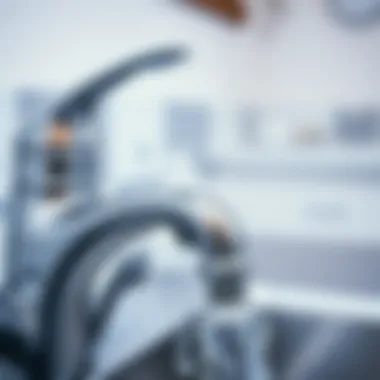
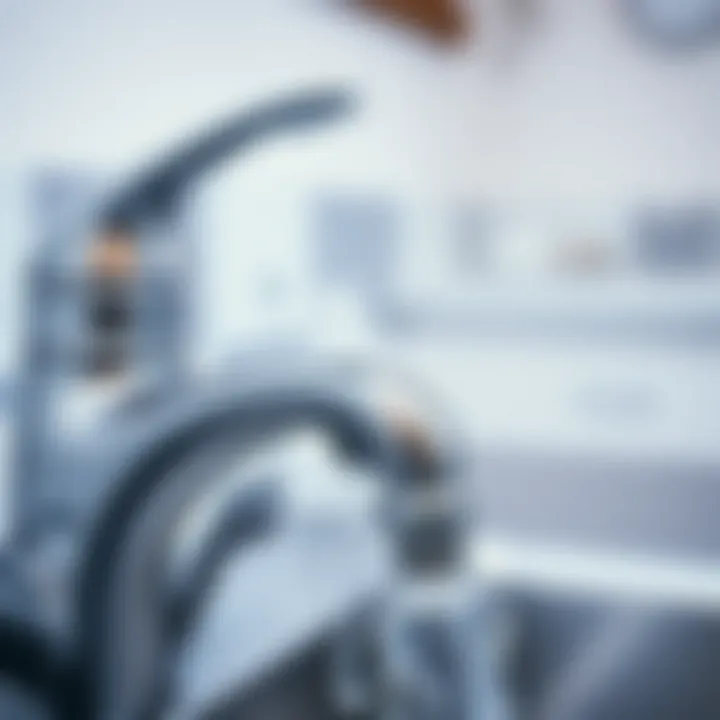
Effects of Low Water Pressure
Low water pressure can be a real thorn in the side of any homeowner. Imagine trying to fill a pot with water, only to find it trickling out at a snail’s pace. This scenario is not just frustrating; it can also lead to several other issues:
- Increased Time for Tasks: Low water pressure can prolong simple tasks, making daily routines less efficient. When washing dishes or cleaning vegetables, a slow flow can lead to added inconvenience.
- Incompatibility with Appliances: Many modern appliances require a certain level of water pressure to operate correctly. Insufficient pressure might prevent them from functioning, leading to potential breakdowns or inefficiencies.
- Clogging Risks: In some cases, low pressure might signal sediment buildup or clogs in the plumbing system. This not only affects the faucet but can also impact the entire water flow throughout the house.
- Inefficient Cleaning: Whether rinsing a pan or filling a kettle, cleaning tasks often require adequate water pressure for best results. Low pressure could result in leftover food particles, requiring more effort and time in cleaning efforts.
Consider this: an efficiently functioning faucet can be likened to a well-conducted orchestra, where each component works in harmony to create a smoother, more enjoyable home experience. Conversely, low water pressure can disrupt that harmony, creating a cacophony of undesirable inconveniences that compromise daily life.
"Investing in high pressure kitchen faucets is not just a decision; it’s a commitment to efficiency and functionality in your kitchen space."
Understanding the vital role of water pressure equips homeowners to make informed decisions when selecting kitchen faucets and enhances their daily kitchen experiences.
For further exploration into plumbing and water systems, consider visiting resources such as Wikipedia or Britannica.
Types of High Pressure Kitchen Faucets
When diving into the realm of high pressure kitchen faucets, understanding the different types is crucial. Each variant offers unique features and benefits, making them suited for various kitchen needs and designs. Homeowners and designers alike should consider not only the style but also the functionality that each faucet type brings to the table. Choosing the right type can significantly enhance both the performance of your kitchen and the ease of daily tasks.
Pull-Down Faucets
Pull-down faucets are celebrated for their versatility and ease of use. Equipped with a spray head that extends down from the faucet, these models are designed to make tasks such as rinsing dishes or filling large pots a breeze. Often, they come with multiple spray settings, allowing you to switch between a steady stream for filling and a spray for cleaning.
One notable advantage of a pull-down faucet is its designed flexibility. It allows users to reach various spots without the hassle of maneuvering the whole faucet. This is particularly useful in busy kitchens where both food preparation and cleaning occur simultaneously. Additionally, the sleek, modern look of many pull-down models can elevate the aesthetic of any kitchen.
Pull-Out Faucets
Similar to pull-down faucets, pull-out faucets feature a detachable head. However, instead of a downward motion, the head pulls out towards you. This design might be more advantageous for certain kitchen layouts, providing a different approach to tasks that require directional flow.
The moment you grab the handle and pull it toward you, you’ll notice how the hose extends. This can feel quite freeing when washing vegetables or cleaning awkward corners of your kitchen sink. It’s also a great option for homeowners who may find that kitchen space is at a premium. Plus, many pull-out faucets are designed with easy docking features, ensuring the spray head retracts smoothly.
Single-Handle Faucets
Single-handle faucets stand out for their simplicity and ease of use. Using a single lever to control water flow and temperature makes them particularly user-friendly. In a bustling kitchen environment, this straightforward operation is often appreciated.
These faucets often require less space around the sink, making them ideal for smaller areas where every inch counts. Moreover, single-handle designs can fit seamlessly into both traditional and contemporary kitchens. Furthermore, these faucets are generally easier to install and maintain compared to their multi-handle counterparts, enhancing convenience for the homeowner.
Deck-Mounted Faucets
Deck-mounted faucets are another popular choice, praised for their sturdy installation directly on the sink or the countertop. This results in a clean, efficient design that integrates well with the overall aesthetics of the kitchen. Deck-mounted faucets are versatile as they come in various styles, including both traditional and modern designs, allowing for a perfect match to your kitchen decor.
Functionally, these models tend to have multiple outlets, ideal for households that may need to connect additional kitchen appliances, such as dishwashers or water filtration systems. The robustness of a deck-mounted faucet also contributes to its longevity, making it a sound investment for homeowners looking for durability alongside style.
Choosing the right faucet type not only enhances the kitchen's functionality but also contributes to the overall design harmony of the space.
In summary, with a wealth of options available, selecting the right type of high pressure kitchen faucet is essential for achieving both utility and style in your kitchen. Understanding the features and benefits of pull-down, pull-out, single-handle, and deck-mounted faucets can guide homeowners and designers in making a choice that suits their specific needs.
Design Considerations
When it comes to selecting high pressure kitchen faucets, design considerations play a pivotal role in harmonizing functionality with aesthetics. It's not just about how a faucet looks; it’s also about its durability, usability, and compatibility with your kitchen. The right design can enhance not only your kitchen’s efficiency but also its overall vibe.
Material Choices
Choosing the right material for a kitchen faucet is crucial. Stainless steel is often considered the gold standard. It’s robust, resists corrosion, and can withstand daily wear and tear. Alternatively, brass faucets, which are known for their durability, offer a classic look and can be plated with chrome or nickel for added appeal.
Some homeowners may opt for ceramic faucets, which can provide a unique aesthetic, but they tend to be more delicate. It's worth noting, however, that ceramic can sometimes outperform metal in terms of resistance to scratches and tarnishing.
Ultimately, the choice of material comes down to personal preference, style, and the amount of use the faucet will see.
Finish Options
Finish options not only affect the faucet's look but also its functionality. Common finishes include polished chrome, which has a reflective quality and can brighten the space. Matte black, on the other hand, brings a sophisticated touch and can be easier to clean as it hides water spots better than shinier counterparts.
For those looking for a vintage flair, oil-rubbed bronze offers warmth and character, perfect for a rustic or traditional kitchen. In selecting a finish, consider how it complements your existing hardware and appliances, and don't overlook maintenance—some finishes might require more care over time to keep them looking pristine.
Ergonomics and Functionality
When talking about ergonomics and functionality, it’s all about how comfortable a faucet is to use day in and day out. A well-designed faucet should fall naturally in hand, with controls that are easy to reach and manipulate. Consider options like a high-arc design that not only looks appealing but also allows for better clearance when filling large pots.
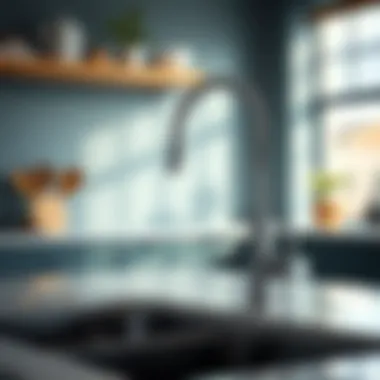
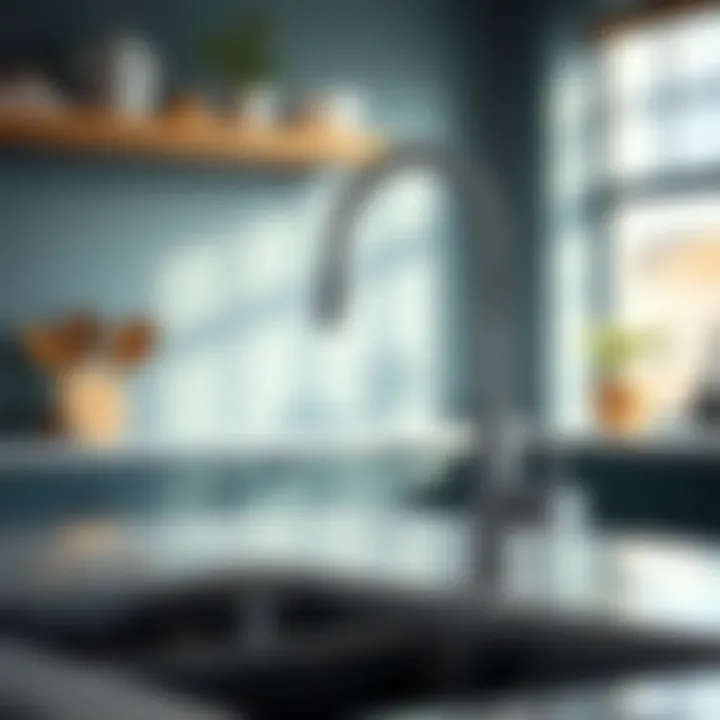
Features such as pull-down sprayers or touchless technology can enhance usability, making kitchen tasks less cumbersome. If your faucet makes your routines easier, you're likely to enjoy your time in the kitchen even more.
"The best kitchen faucet is not just about performance; it's a blend of beauty and thoughtful design that serves you seamlessly every day."
Installation of High Pressure Kitchen Faucets
Installing a high pressure kitchen faucet is not just about adding a functional piece to your kitchen; it’s about enhancing your cooking experience as well as elevating the overall aesthetic appeal of one of the most used spaces in your home. This section dives into why proper installation is essential, detailing the straightforward steps involved and listing the tools you'll need to ensure a successful setup.
Every homeowner understands that the kitchen is the heart of the home. Therefore, the faucet you choose can play an integral role in your kitchen's efficiency and style. A high pressure faucet delivers a robust water flow, helping with everything from filling pots swiftly to facilitating quick cleanup. Understanding the installation process is crucial not just for the immediate benefits of convenience but also for the long-term functionality and reliability of your faucet.
Inadequate installation can lead to problems down the line, including leaks and inadequate water pressure. Getting it right from the onset can spare homeowners a heap of trouble and possibly more significant plumbing issues later on. So let’s roll up our sleeves and explore the step-by-step installation process and what you'll need to get going.
Step-by-Step Installation Guide
- Prepare Your Workspace
Clear the area under your sink. Remove any old fixtures if necessary. - Turn Off the Water Supply
Locate the shut-off valves under the sink and turn them clockwise to halt water flow. - Remove the Old Faucet
Disconnect the water lines attached to the old faucet using a wrench. Remove any mounting hardware. - Install the New Faucet
Follow the manufacturer’s instructions. Usually, you will position the faucet in the mounting hole—the instructions will guide you through the specific steps unique to your model. - Secure the Faucet
Use the provided hardware to firmly secure the faucet in place. This will prevent any movement or leakage. - Connect the Water Supply
Attach the supply lines to the new faucet, ensuring proper alignment with any washers or gaskets. - Turn the Water Supply Back On
Slowly turn the shut-off valves counterclockwise and check for any leaks around the connections. - Final Check & Clean Up
Once everything's connected and there are no leaks, clean up your work area and dispose of any old materials properly.
By systematically following these steps, you can avoid the pitfalls of hasty installations and make sure your faucet works just as it should.
Tools Required for Installation
Before you dive into installation, it’s essential to gather the necessary tools to make the process smooth and efficient. Here’s what you will need:
- Adjustable Wrench: For tightening and loosening fittings.
- Phillips and Flathead Screwdrivers: Often needed for attaching the faucet or removing the old one.
- Teflon Tape: To ensure a watertight seal on threaded connections.
- Basin Wrench: Helpful for tightening nuts and bolts in hard-to-reach areas.
- Bucket or Towel: To catch any water that may spill during disconnection or connection processes.
By having these tools ready, you’ll position yourself for a straightforward installation. No one wants to scramble for a wrench when they’re elbow-deep under the sink, right?
"Proper preparation prevents poor performance."
Taking the time to understand the installation process and equip yourself with the right tools makes all the difference in achieving a successful setup. Not only will it provide a reliable source of water for culinary delights, but it will also enhance your kitchen’s overall functionality.
Maintenance Tips
Maintaining your high pressure kitchen faucet is not just about keeping it clean; it’s about prolonging its lifespan, ensuring optimal performance, and maintaining a healthy kitchen environment. When water pressure runs high, the stress on the components can be significant. Regular maintenance allows you to catch small issues before they turn into bigger headaches.
Here are some key maintenance tips:
- Regular cleaning reduces the buildup of mineral deposits.
- Prompt troubleshooting minimizes the risk of leaks and damages.
- Adjusting settings where necessary can enhance performance without costly repairs.
By incorporating a few simple practices into your routine, you can enjoy the benefits of a reliable faucet for years to come.
Regular Cleaning Practices
Keeping your faucet clean is paramount. Not only does it prevent grime buildup, but it also ensures that the finishing remains intact and the functionality is preserved. Here are some effective cleaning practices:
- Wipe Down Regularly: Use a soft cloth and warm soapy water to wipe the exterior of the faucet at least once a week. This won't take much time, but it keeps the shine.
- Descale with Vinegar: If you live in an area with hard water, the buildup of calcium and lime deposits is likely. Soak a cloth in vinegar and wrap it around the faucet's aerator. Leave it for an hour and then scrub lightly.
- Check the Aerator: Remove and clean the aerator every few months. It's a small mesh that can clog easily and cause changes in water pressure.
- Avoid Harsh Chemicals: Stay away from abrasive cleaners or harsh chemicals that can scratch or tarnish the finish of your faucet.
Following these steps can save you from potential clogs and maintenance issues down the line.
Troubleshooting Common Issues
High pressure kitchen faucets can exhibit issues, just like any other fixture. Identifying and addressing these problems early can mitigate future inconveniences. Here are some common issues and how to troubleshoot them:
- Dripping Faucet: This often means a worn-out washer. Simply replace the washer and tighten any connections that may have loosened over time.
- Reduced Water Flow: Check whether the aerator is clogged or if there are deposits inside the faucet. Cleaning or replacing the aerator usually solves this issue.
- Strange Noises: If your faucet rattles or makes a banging sound, it could be because of high water pressure. Adjusting the water pressure in your home may be necessary.
- Leaking Base: Inspect the base where the faucet connects to the sink. Tighten the nuts and inspect seals or washers that might need replacing.
Keeping an eye on these factors can alleviate headaches in the future. Remember, an ounce of prevention is worth a pound of cure.
With these maintenance tips in your toolkit, your high pressure kitchen faucet can function effectively and look great too. Regular attention can save both time and money in the long run.
For further resources, check out Wikipedia on plumbing or visit Home Improvement forums for discussions and tips.
Impact of High Water Pressure on Faucet Longevity
When considering kitchen faucets, one must not overlook the delicate balance of water pressure and its direct impact on durability. High water pressure does wonders for the efficiency of a faucet, making it easier to rinse dishes and fill pots in a jiffy. However, how high is too high? This is a crucial aspect for homeowners wishing to invest in a faucet that will stand the test of time.
Selecting the Right Pressure Levels
Finding the sweet spot for water pressure isn’t just guesswork; it requires an understanding of your home's plumbing. Most household systems are designed to handle between 40 to 60 PSI (pounds per square inch), which generally offers optimal performance without risking damage to your fixtures.
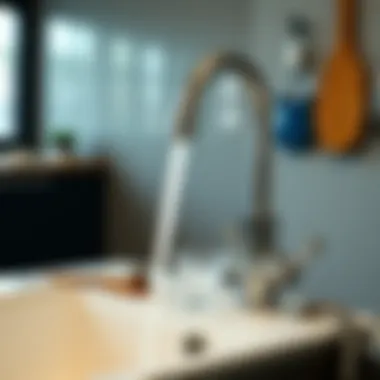
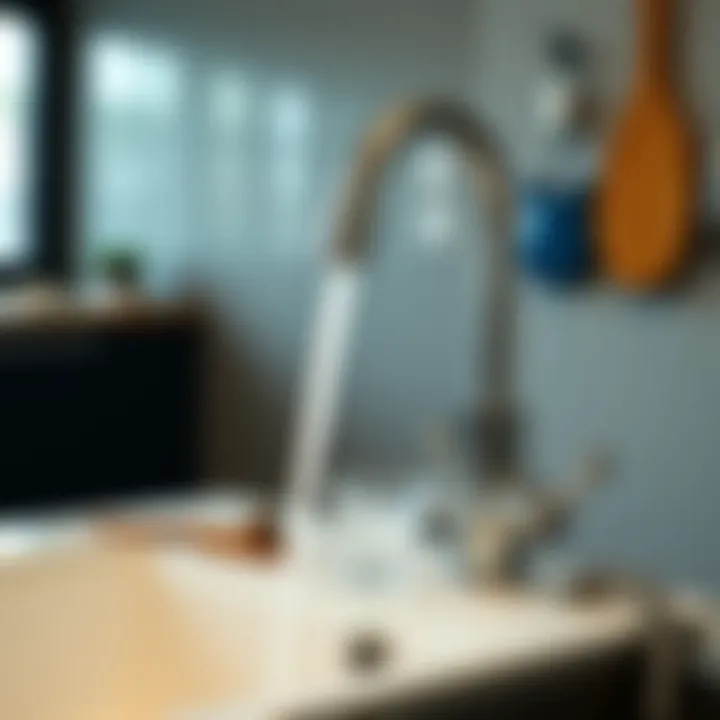
- Measure Your Current Pressure: Homeowners can use a pressure gauge to find out what their current settings are. This can help inform any adjustments that need to be made.
- Adjustments: If your pressure is too low, you might need to look into your water supply system; if it’s too high, a valve may need to be installed to regulate the flow.
- Consult a Professional: For the best results, it’s always good to consult with a plumbing professional. They can give advice tailored to your specific setup.
Potential Risks of Excess Pressure
Maintaining high water pressure isn't all roses. With benefits come certain risks. Excessive pressure can lead to wear and tear on your faucet mechanisms, causing leaks or premature failure. Common issues arising from overly high water pressure include:
- Washer Damage: The internal washers can wear down quickly, leading to leaks and costly repairs.
- Cracked Components: Over time, constant high pressure can cause parts of the faucet to crack or break entirely.
- Unnecessary Water Loss: A faucet that leaks isn't just an inconvenience; it can also lead to wasted water – both economically and environmentally.
To encapsulate some of this wisdom:
"Striking a balance on pressure can keep your faucet in shipshape, saving you from a leaky headache down the line."
In summary, achieving and maintaining the correct water pressure is crucial for not just the immediate functionality of a faucet, but for its longevity as well. A little extra care in this area can pay dividends in the long run, making your faucet a dependable fixture in your kitchen for years to come.
Energy Efficiency and Environmental Considerations
When it comes to high pressure kitchen faucets, the topic of energy efficiency and environmental considerations can't be brushed aside. With water conservation becoming an urgent global issue, opting for faucets that combine both performance and sustainability is increasingly vital for homeowners and designers alike. A high pressure kitchen faucet that effectively saves water while providing strong performance can contribute to a reduction in environmental impact and utility bills.
Water Saving Technologies
Water-saving technologies are revolutionizing the way we think about our kitchen faucets. Many high pressure models are now designed with efficient aerators and smart flow restrictors that reduce water usage without sacrificing pressure. These technologies can be the hidden superheroes of your kitchen, making sure you’re washing dishes or rinsing vegetables with just the right amount of water.
Some examples of widely adopted water saving technologies include:
- Aerators: These devices mix air with water, allowing for a steady flow with less overall water use.
- Flow Restrictors: Limiting the maximum flow rate can significantly conserve water without impacting performance.
- Smart Sensors: Some high-end faucets come equipped with touchless technology, activating the water flow only when needed, further minimizing waste.
By adopting these technologies, not only do you save water, but you contribute to a larger movement towards sustainable living.
Long-Term Cost Benefit Analysis
Installing a high pressure kitchen faucet equipped with energy-efficient features can lead to substantial long-term savings. While the initial investment might be slightly higher, the benefits often outweigh the costs over time. Here’s how:
- Utility Bill Savings: A more efficient faucet can lead to lower water and energy bills. With less water usage, you’re digging less into your wallet each month.
- Durability: Many efficient models are built with high-quality materials designed to withstand wear and tear, preventing frequent replacements.
- Increased Home Value: Eco-friendliness is attractive to many prospective buyers. Investing in sustainable fixtures can enhance your home's appeal when you come to sell.
"Investing in high pressure faucets that focus on efficiency isn't just good for the environment—it's a wise financial decision."
In wrapping up, choosing a high pressure kitchen faucet integrated with water saving technologies not only bodes well for our planet but also brings about significant cost benefits in the long run. The connection between efficiency and environmental consciousness is stronger than ever, making it imperative for homeowners and designers to prioritize these elements in their selection process.
Choosing the Right Faucet for Your Kitchen
Selecting the right kitchen faucet is tanto importante as choosing the finest cut of steak for your meal. It's not just about aesthetics; it's about ensuring the functionality and durability of your kitchen's centerpiece. The right faucet can elevate your cooking space, making daily tasks seamless while reflecting personal style. With the myriad of options available today, understanding your unique needs helps narrow down the choices and makes the decision-making process less overwhelming. Here, we’ll explore what to consider so you can make an informed choice that marries form and function flawlessly.
Assessing Your Kitchen Needs
When contemplating a kitchen faucet, first and foremost is considerin’ your own needs. Think about the following factors:
- Usage Frequency: If you find yourself cookin’ up a storm daily, you want a faucet that can keep up with that pace. Look for robust materials, like brass or stainless steel, that can withstand daily wear and tear.
- Space Constraints: Available space in your kitchen may heavily influence your choice. Compact or foldable faucets are perfect for smaller kitchens, while a more substantial pull-down model may suit an expansive counter.
- Sink Size and Configuration: A large farmhouse sink pairs well with a tall arc faucet, while a smaller sink might necessitate a more compact model. Understanding your sink's dimensions helps ensure a harmonious look.
- Style and Theme: If your kitchen sports a modern aesthetic, go for sleek, minimalist designs. On the opposite side, a vintage-style kitchen may lean toward traditional faucets with intricate designs and finishes.
These parameters not only help in selecting a nozzle but provide clarity on features, such as single vs. dual handles, spray settings, and even water efficiency. A quick tip: try visualizing the faucet in your space; it can significantly guide your choice.
Reading Reviews and Recommendations
Next up is doin’ your homework. These days, a wealth of information is available at the click of a button. Here’s how to navigate through reviews and recommendations:
- Online Reviews: Websites like Amazon and Home Depot are treasure troves for honest customer opinions. Filter reviews based on verified purchases to ensure authenticity. Look for patterns in feedback, be it about ease of installation or long-term durability.
- YouTube Reviews: Some folks articulate their experiences in video form. Watch demonstrations to see the faucet in action and to understand installation fears or user errors.
- Social Media and Forums: Engage with platforms like Reddit, or join Facebook groups dedicated to home improvement. Here you can ask for opinions, share personal experiences, and even get advice on specific brands or models.
- Expert Recommendations: Seek out home improvement blogs or magazines that specialize in appliances. They often conduct in-depth reviews and comparisons that can provide invaluable insight to potential buyers.
In summary, navigating these resources makes it easier to sift through options with clarity, arming you with the know-how to make a savvy purchase with confidence. > "A well-chosen faucet can be a worthy investment, combining efficiency with style, ensuring that the heart of your home runs smoothly."
Making these informed choices is crucial, especially when you consider the utility and ambiance your kitchen faucet brings. With the right approach, you can be sure that your kitchen faucet will harmonize with your lifestyle and design aspirations.
End
In wrapping up our exploration of high pressure kitchen faucets, it's essential to grasp the full significance of this topic within the realm of modern kitchens. Homeowners and designers alike are increasingly recognizing that the choice of faucet goes far beyond mere aesthetics; it is a decision that intertwines functionality with style and practicality.
Understanding the vital role that water pressure plays cannot be overstated. High pressure faucets not only facilitate efficient cleaning but also enhance the overall user experience in the kitchen. By choosing the right type of faucet, one can ensure a steady flow of water, which can be a game changer for meal prep or washing up.
Moreover, considerations for installation and maintenance further add layers of importance to this subject. A well-installed faucet can mitigate issues like leaks or poor water flow, while regular maintenance can extend the lifespan of the faucet, preserving both its usability and visual appeal.
The benefits of high pressure kitchen faucets are not limited to functionality alone; they also encompass energy efficiency and environmental concerns. By understanding how to select a faucet that optimizes water usage without sacrificing pressure, homeowners contribute to sustainable practices while still enjoying the luxuries of modern plumbing.
"The right kitchen faucet can become the unsung hero of your home, transforming everyday tasks into effortless endeavors."
For anyone looking to enhance their kitchen environment, investing time in understanding high pressure kitchen faucets clearly yields manifold benefits. It’s about more than just choosing a spout; it’s about elevating everyday living through informed decision-making. The details discussed throughout this guide empower homeowners and designers to make choices that fuse utility with elegance. With thoughtful consideration, selecting the perfect faucet becomes a noteworthy step in crafting a kitchen that truly reflects one's personal style while never compromising on functionality.



